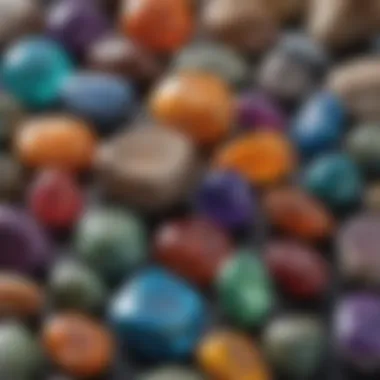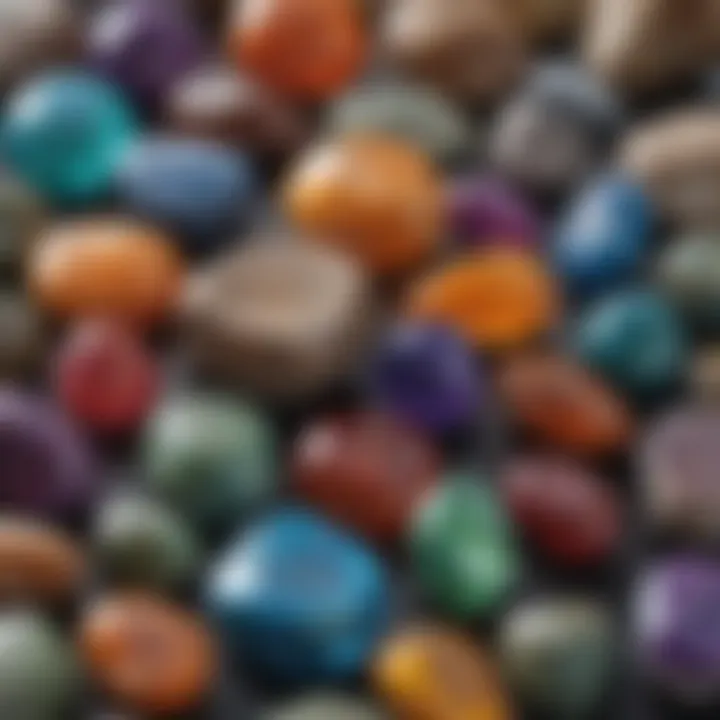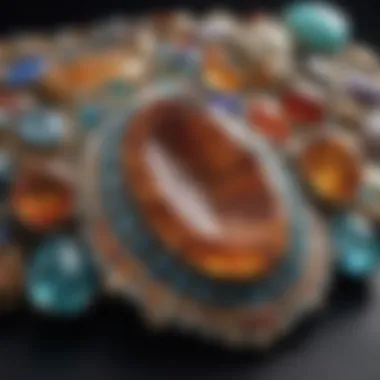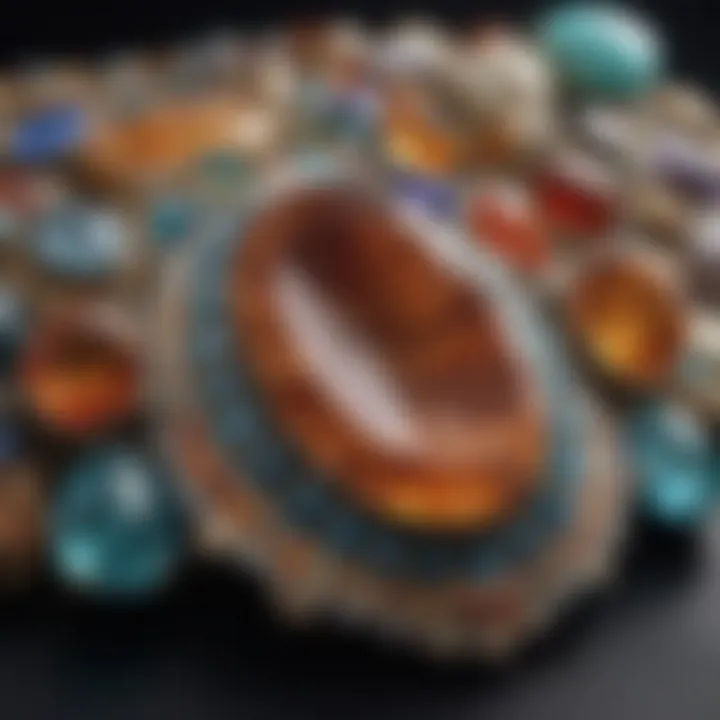Semi-Precious Stones Identification Guide


Intro
The fascinating world of semi-precious stones is not just about their beauty, but also their complexity. Understanding these gems encompasses a variety of aspects, from their unique characteristics to their historical context. This guide aims to provide both novice and experienced collectors with essential insights and identification techniques. Through charts and detailed descriptions, this resource nurtures a deeper appreciation for semi-precious stones.
Featured Collectible of the Month
Overview
This month’s highlighted collectible is the amethyst. Known for its stunning purple hue, amethyst has been cherished throughout history. Its vibrant color can range from light lavender to deep violet, making it a desirable stone for jewelry and decorative objects. The stone has garnered attention for its metaphysical properties, which include fostering calmness and clarity.
Historical Significance
Amethyst has a rich history, having been used in ancient civilizations such as Egypt and Greece. It is notable that the Greeks believed it could prevent intoxication, leading to its widespread use in wine goblets. The stone was highly valued, often reserved for royalty. This historical relevance adds layers to amethyst’s allure, making it not only a collectible but also a testament to our cultural heritage.
Identification Techniques
Identifying semi-precious stones requires an eye for detail. Various techniques and resources can assist collectors in distinguishing different types.
Visual Characteristics
Each semi-precious stone possesses unique visual qualities. For example:
- Color: The most noticeable trait, varies significantly between stone types.
- Clarity: Refers to the transparency of the stone. Some stones may have inclusions while others may appear flawless.
- Luster: Indicates how light reflects off the surface, affecting appearance. Different types include glassy, pearly, or dull.
- Hardness: Determined by the Mohs scale, it helps in identifying durability.
Resources for Identification
A variety of resources can aid in the identification of semi-precious stones. Here are some to consider:
- Books: Reference texts such as "The Gemstone Handbook" can provide comprehensive overviews.
- Online Databases: Websites like Wikipedia and Britannica offer factual information and historical context.
- Community Forums: Engage with fellow collectors on platforms like Reddit to share insights and experiences.
Identifying stones is not only about knowing their appearance but also understanding their unique attributes related to their formation and environment.
By using these techniques and resources, collectors can enhance their identification skills, allowing for a richer collection experience.
Preface to Semi-Precious Stones
Understanding semi-precious stones is crucial for anyone interested in geology or stone collection. These natural formations, which include a wide variety of minerals and textures, have distinct characteristics that attract collectors and enthusiasts. The importance of studying semi-precious stones lies in their aesthetic, historical, and cultural significance. This article aims to provide a comprehensive examination of such stones, focusing on their identification and classification through various techniques.
Definition and Classification
Semi-precious stones are defined as minerals that are not classified as precious, which typically include diamonds, rubies, emeralds, and sapphires. They can be found in a range of colors, shapes, and sizes, making them unique. The classification often depends on several factors:
- Mineral composition: Each stone has a unique chemical structure which influences its properties.
- Formation and origin: The geological processes that lead to their creation can vary greatly.
- Value and market demand: Though not deemed precious, some semi-precious stones can command high prices in the marketplace.
Such classification is important because it helps collectors understand the value and rarity associated with various stones.
Historical Perspective
The history of semi-precious stones dates back thousands of years. Ancient civilizations valued these stones for their beauty and supposed mystical properties. For instance, lapis lazuli has been revered since ancient Mesopotamia for its deep blue color. Many cultures have used semi-precious stones in jewelry, artifacts, and even in religious practices, showcasing their significance throughout history. Learning about the historical context provides insight into how these stones have been appreciated and utilized over time, enriching our understanding of their cultural impact.
Common Misconceptions
There are several common misconceptions surrounding semi-precious stones. One of the most widespread is the belief that the term "semi-precious" implies a lesser quality compared to precious stones. In reality, the classification is more about market perception and rarity than inherent quality. Another misconception is that all semi-precious stones are easily obtainable. While many are common, some are rare and can be hard to find, which may significantly impact their value. By clarifying these misconceptions, new collectors can make informed decisions about their collections.
Scientific Basis of Stone Identification
Understanding the scientific basis of stone identification is essential for both collectors and enthusiasts of semi-precious stones. This section highlights vital elements that contribute to the effective identification, classification, and appreciation of these geological wonders. The skills needed to identify semi-precious stones not only enhances one’s collecting experience but also promotes a deeper understanding of their physical characteristics and origins.
Physical Properties of Stones


Identifying semi-precious stones relies heavily on understanding their physical properties. Physical traits such as hardness, color, and luster play a crucial role in classification and selection.
Hardness
Hardness is a distinct feature that indicates how resistant a stone is to scratching. It is typically measured on the Mohs scale, ranging from 1 (talc) to 10 (diamond). The hardness of a stone impacts its durability and suitability for various uses.
- Key Characteristic: The ability to resist abrasion makes hard stones more desirable, especially in jewelry.
- Benefits: Higher hardness means lower likelihood of damage when used in everyday objects.
- Unique Feature: Stones with a hardness above 5 are generally safer for routine wear, which makes them a popular choice among collectors.
- Advantages/Disadvantages: While harder stones are more resilient, they can also be more challenging to work with for intricate designs.
Color
Color is one of the most visually distinctive attributes of any semi-precious stone. The hue of a stone comes from its composition and how it interacts with light.
- Key Characteristic: Color provides immediate recognition, aiding in basic identification.
- Benefits: Stones with rich and vibrant colors typically fetch higher market values due to their aesthetic appeal.
- Unique Feature: Color can vary widely even within the same type of stone, creating challenges for consistent identification.
- Advantages/Disadvantages: While a vivid color stands out, frequent variations may lead to misidentification among less experienced collectors.
Luster
Luster describes how light interacts with the surface of the stone. It can be classified as metallic, vitreous, dull, and more.
- Key Characteristic: It assists in providing an overall visual impression of a stone.
- Benefits: Luster can enhance a stone's beauty and influence perception of its quality.
- Unique Feature: Stones possessing a distinctive luster often garner more attention in the market.
- Advantages/Disadvantages: While a higher luster can signify quality, it does not directly correlate with the stone's durability or strength.
Special Techniques for Identification
Identifying stones often requires more than just examining physical properties. Specialized techniques enhance the accuracy of identification and are essential for serious collectors.
Refraction
Refraction measures how much light deviates as it passes through a stone. It is crucial for understanding the optical properties of semi-precious stones.
- Key Characteristic: This provides insights into the identity and clarity of the stone.
- Benefits: Understanding refraction can prevent misidentification.
- Unique Feature: Different stones have unique refractive indices, making this technique quite effective.
- Advantages/Disadvantages: While useful, it requires precision and the right equipment, which can sometimes be a barrier to casual collectors.
Polariscope Testing
Polariscope testing is another important technique that examines how a stone behaves under polarized light.
- Key Characteristic: It helps in determining if a stone is single-refractive or double-refractive.
- Benefits: This method is highly effective for distinguishing between similar-looking stones.
- Unique Feature: Polariscope testing can reveal strain patterns that are not visible through naked eye observation.
- Advantages/Disadvantages: While it enhances identification accuracy, it requires specific instruments that may not be readily available to all collectors.
The Role of Gemmology
Gemmology is the scientific study of gemstones. It offers a formal framework for examining semi-precious stones, connecting physical properties, identification techniques, and market valuations.
Gemmologists use their expertise to assist collectors and appraisers in understanding the finer details of stones. They enhance knowledge about how to best care for and assess the value of semi-precious stones. This scientific approach ensures that collectors make informed decisions based on reliable data rather than assumptions or superficial judgments.
Identification Charts and Their Importance
Identification charts serve as vital tools in the realm of semi-precious stones. They allow both novice and seasoned collectors to effectively identify and compare different stones. The importance of these charts cannot be understated; they enhance understanding and provide clarity amidst the vast variety of stones available.
These charts offer structured information that simplifies the process of identification. With varying characteristics outlined distinctly, collectors can easily evaluate their specimens against established benchmarks. This creates an efficient way to bridge knowledge gaps and fosters informed decision-making. Moreover, identification charts contribute to the preservation of knowledge, allowing the gemological community to share standardized references for educating others about semi-precious stones.
What is an Identification Chart?
An identification chart is a systematic representation of various semi-precious stones. It typically includes relevant details such as physical properties, color variations, and luster descriptions. These charts are designed to assist individuals in recognizing and categorizing stones based on defined criteria. By providing a visual or textual framework, they streamline the identification process and help collectors understand the nuances of different stones.
Types of Charts
Visual Reference Guides
Visual reference guides are a crucial asset in identifying stones. These charts present images alongside descriptions, enabling collectors to make quick comparisons. The key characteristic of visual reference guides is their pictorial nature, which enhances retention of information. This makes them particularly beneficial for visual learners and those new to collecting. A unique feature of these guides is their ability to depict subtle color differences and inclusion patterns, which are often critical in identification. However, one disadvantage is that individual stones may vary in appearance, making it essential to verify with multiple sources before drawing conclusions.
Textual Descriptions
Textual descriptions offer a different approach to identification. They provide detailed written explanations of a stone's properties, often structured in a systematic format. This charts' main feature is its emphasis on written characteristics like hardness, density, and refractive index. This can be a beneficial choice for readers who prefer in-depth analysis over visual aids. Moreover, textual descriptions can convey more information than images alone, such as geological formation or historical significance. However, the downside is that extensive reading may overwhelm those seeking a quick reference.


How to Use Identification Charts Effectively
To use identification charts effectively, one must first familiarize oneself with the key characteristics of the stones in question. Begin by identifying the stone's color, luster, and texture. Cross-reference these properties with the chart. It is helpful to take notes or mark specific attributes.
Another strategy is to combine visual and textual descriptions. Using both types of charts allows for a more comprehensive approach. One can start with visual identification and then confirm findings with the textual data. Lastly, practice is key. The more frequently one consults the charts, the better one will become at identifying stones accurately.
Important Note: Using multiple identification methods decreases the likelihood of misidentification.
Thus, whether using visual reference guides or textual descriptions, understanding how to effectively apply identification charts can significantly enhance a collector's experience.
Comprehensive Identification of Specific Semi-Precious Stones
The identification of specific semi-precious stones holds significant importance in the broader context of gemstone appreciation. By being able to accurately recognize and classify these stones, collectors can ensure authenticity and improve their overall knowledge of geology. Each stone has unique characteristics, which, when understood, can enhance not only the aesthetic value of the pieces but also their historical context and cultural implications.
Understanding the specific attributes of semi-precious stones benefits collectors in many ways. First, it aids in their collection strategy. Gaining insight into factors such as rarity, demand, and value can inform purchasing decisions. Furthermore, identifying stones precisely can help avoid misrepresentation or fraud in the market. The process of gaining this knowledge requires diligence and attentiveness, as each stone presents its unique set of challenges.
Moreover, proper identification leads to more informed care and maintenance practices for collectors. Different stones may require specific cleaning methods or storage solutions to preserve their integrity and luster. Accurate identification thus becomes a critical skill that further enriches the collecting experience.
Ultimately, comprehensive identification serves not only as a tool for collectors but also as a gateway to a deeper understanding of geology. It encourages exploration and curiosity, prompting collectors to learn more about natural processes, origins, and the science surrounding these intriguing materials.
Amethyst: Unique Attributes
Amethyst is widely recognized for its captivating violet hue. This variation in color can range from light lavender to deep purple, influenced by the iron content during its formation. Understanding these nuances can aid in identifying high-quality specimens. The transparency and quality of the stone are also important properties; a clear, deep-colored amethyst is typically more sought after.
What makes amethyst particularly interesting is its historical value. Once considered as precious as diamonds, it has been popular in jewelry throughout history. Collectors should note that heated amethyst can sometimes show light yellow hues, resembling citrine; thus, distinguishing between the two is essential.
Citrine: Identification Tips
Citrine is often praised for its sunny yellow to brownish-orange color. When identifying citrine, one key aspect is its clarity. High-quality citrine displays a transparent quality, lacking internal flaws. Its authenticity can sometimes be verified through a simple scratch test, as genuine citrine is relatively hard, sitting at 7 on the Mohs scale.
Another way to identify citrine is by observing its color distribution. Unlike amethyst, which has various shades, citrine's color should be consistent throughout the stone. It is also crucial to be wary of imitation stones, which can appear similar but often lack the vibrancy of true citrine.
Lapis Lazuli: Characteristics and Uses
Lapis lazuli is a striking blue stone dotted with gold flecks, usually due to the presence of pyrite. This mineral’s unique appearance makes it easy to identify, but collectors should also be aware of its historical significance. Ancient civilizations, particularly the Egyptians, valued lapis lazuli for its beauty and believed it possessed protective qualities.
Aside from aesthetic appeal, lapis lazuli has been used in various applications, from jewelry to ornamental objects. Recognizing its applications can deepen a collector's appreciation for the stone. Its rarity, primarily sourced from Afghanistan, adds to its allure and market value.
Turquoise: From Mining to Identification
Turquoise showcases a distinctive robin’s egg blue to greenish-blue color. Its unique veins and patterns can help differentiate it from other stones. One important identification factor is the stone's matrix, as this can reveal insights on its origin. Turquoise is typically found in arid regions, often mined from copper deposits.
When examining turquoise, one must also consider the hardness. Natural turquoise usually sits at 5 to 6 on the Mohs scale, which can sometimes lead to scratches. Additionally, genuine turquoise feels cool to the touch compared to glass imitations. Understanding these characteristics aids in accurate identification.
Jade: The Complexities of Identification
Jade encompasses two distinct minerals: jadeite and nephrite. Each of these varieties possesses its unique features and value. Jadeite is generally considered to be more valuable than nephrite. Jade can appear in several colors, but green is the most recognized. Identifying jade requires attention to texture and translucence. True jade is tough and has an almost waxy feel.
One challenge in identification is the prevalence of treated and synthetic stones that mimic jade. Advanced testing techniques may be necessary to ensure authenticity, making a basic understanding of the differences between jade types essential. Collectors should be cautious and knowledgeable when acquiring stones labeled as jade to navigate these complexities effectively.
"Understanding the unique properties of each semi-precious stone is not just academic; it profoundly impacts the appreciation and value of your collection."
Collecting and Caring for Semi-Precious Stones
Collecting semi-precious stones is not merely a hobby; it is a pursuit that requires attention to detail and thoughtful stewardship. The way collectors manage their stones has a profound impact on both the longevity of the pieces and the overall experience of the collecting journey. Understanding how to properly store, clean, and care for these gems is essential. Such practices not only preserve their beauty and integrity but also enhance the collector's appreciation of their natural allure and value.
Storage Solutions and Best Practices
Effective storage solutions are crucial for maintaining the quality of semi-precious stones. First, it is important to choose a controlled environment for storage. This means avoiding direct sunlight, as prolonged exposure can fade colors. Humidity also plays a role; keeping the stones in a dry place prevents any potential mold or mildew, which could be harmful especially to softer stones.
A few recommended storage practices include:


- Use of Soft Pouches: Wrap each stone in a soft cloth or store in individual fabric pouches. This prevents scratches and minimizes friction between stones.
- Dedicated Containers: Invest in a dedicated jewelry box or display case with compartments. This allows for organized storage and easy access without unnecessary handling.
- Temperature Control: Store in a place with stable temperature conditions, avoiding extremes that could cause cracking or dulling of the stones.'
Following these guidelines helps in keeping the stones in optimal condition, ensuring that they remain beautiful for years to come.
Cleaning Methods for Preserving Quality
To maintain the aesthetic and structural integrity of semi-precious stones, regular cleaning is necessary. The methods used depend on the type of stone and its properties. Here are some effective cleaning methods:
- Gentle Washing: Most stones can be cleaned with warm water and a mild soap. Use a soft brush or cloth to gently scrub away dirt and oils.
- Avoid Harsh Chemicals: Never use bleach or ammonia-based cleaners, as these can damage the surface of the stone.
- Ultrasonic Cleaners: For stones that can withstand vibrations, ultrasonic cleaners can be effective. However, always verify the safety of the stone for this method beforehand.
- Drying: After washing, thoroughly dry each stone with a clean, soft cloth to prevent water stains and keep them looking polished.
By consistently applying these cleaning methods, collectors can preserve the aesthetic quality and luster of their semi-precious stones.
Avoiding Common Collecting Mistakes
When embarking on a collecting journey, new and even seasoned collectors often make some common mistakes that can jeopardize their collection. It is prudent to be aware of these pitfalls:
- Buying without Research: Purchasing stones based on impulse can lead to regret. Always research the origin, authenticity, and market value of stones before buying.
- Neglecting to Learn about Each Stone: Understanding the specific needs of each type of stone in terms of care and storage is crucial. Ignorance can lead to damage or loss of value.
- Improper Handling: Handling stones without care can lead to cracks and scratches. Always handle them gently and store them properly.
- Ignoring Documentation: Keeping documentation, such as purchase receipts and certificates of authenticity, can prevent issues with sale or trade later on.
Collecting semi-precious stones can be rewarding. However, diligent care and awareness of best practices are necessary to ensure a successful and enjoyable collecting adventure.
The Role of Semi-Precious Stones in Modern Society
Semi-precious stones hold significant value in modern society, reflecting both aesthetic appeal and cultural importance. They are more than just decorative items; they are intertwined with social practices, health beliefs, and environmental considerations. Understanding the role of these stones can deepen appreciation for their multifaceted presence in our lives.
Uses in Jewelry and Decoration
Semi-precious stones are widely used in the jewelry industry. They are popular for their beauty and unique characteristics. Artists and designers transform these stones into rings, necklaces, bracelets, and more. The colors and patterns of stones like amethyst, turquoise, and citrine make each piece distinctive, appealing to various tastes.
The use of semi-precious stones in home decor is also notable. They can be found in items such as decorative bowls, coasters, and even sculptures. These objects enhance interior spaces, creating a connection between nature and personal style. The versatility of semi-precious stones enables them to fit seamlessly into various design themes.
Cultural Significance and Symbolism
Culturally, semi-precious stones carry rich meanings. Many cultures have ascribed spiritual properties to these stones. For many people, wearing or possessing certain stones is thought to bring good fortune or protection. For instance, quartz is often associated with healing properties, while lapis lazuli signifies wisdom and truth.
Each stone’s symbolism can vary across cultures. In some traditions, jade represents purity and moral integrity, while in others, turquoise is sacred and symbolizes protection. This cultural dimension adds depth to their value, as they serve not just as decoration but also as carriers of tradition and belief.
Therapeutic Claims and Practices
In recent years, there has been increased interest in the therapeutic claims associated with semi-precious stones. Some believe that these stones can promote healing and emotional well-being. While scientific evidence is limited, practices such as crystal healing have gained popularity. Practitioners use semi-precious stones for various treatments, including reducing anxiety or enhancing meditative practices.
The concept of using stones for therapy is rooted in the belief that each stone has specific energy vibrations. For example, rose quartz is often used to promote love and compassion, while black tourmaline is thought to provide protection against negative energy.
"The belief in the therapeutic powers of semi-precious stones reflects a broader human desire for connection with nature and self-improvement."
Finale: The Future of Semi-Precious Stone Appreciation
As we look ahead, the appreciation of semi-precious stones continues to evolve. The reasons for this shift are multifaceted, touching on trends, sustainability, and the increasing interest in learning about these remarkable materials. Each of these elements plays a crucial role in shaping the future of semi-precious stone collecting and use.
Emerging Trends in Collecting
The world of collecting semi-precious stones is witnessing numerous emerging trends. One significant trend is the growing emphasis on authenticity. Collectors are increasingly prioritizing stones that come with verified geologic backgrounds. This ensures that the stones have not only desirable aesthetics but also credible origins. Furthermore, technology has also transformed the collecting landscape. Digital platforms, including e-commerce sites and social media, allow collectors to connect globally.
Also, there is a rise in the popularity of local stones. This shift highlights the importance of regional geology and encourages collectors to appreciate stones from their own locales. With more people becoming engaged in sustainable practices, collectors tend to support local artisans and find beauty in native stones.
Sustainability in Stone Sourcing
Sustainable sourcing of semi-precious stones is becoming more significant. Awareness of environmental issues is increasing. As such, collectors and industry players are looking for stones that are ethically sourced. This means practicing responsible mining methods that do not harm ecosystems or communities.
Certifications are becoming essential. Stones that are certified by organizations emphasize eco-friendly practices and fair labor conditions. This ensures that collectors are informed about the impact of their purchases. Adopting a sustainability mindset not only aligns with modern values but also enhances the appreciation of the stones themselves. Collectors find intrinsic value in stones when they know their origins.
The Continued Journey of Learning and Collecting
The journey of learning does not have to end with initial collection experiences. For both novice and experienced collectors, there is always more to discover. Engaging in workshops, attending mineral shows, and participating in online forums can deepen knowledge and appreciation of stones. Each stone has its own story, related to its formation and history. This profound understanding contributes to the growing appreciation.
"The journey of discovering semi-precious stones is one of continual growth and appreciation."
A commitment to responsible practices not only enriches the community but also ensures that future generations can enjoy the stunning beauty and significance of semi-precious stones.



